
Walter Hood Fitch was a botanical illustrator, born in Glasgow, Scotland, who executed some 10,000 drawings for various publications. His work in colour lithograph, including 2700 illustrations for Curtis's Botanical Magazine, produced up to 200 plates per year.

Adrien René Franchet was a French botanist, based at the Paris Muséum national d'Histoire naturelle.
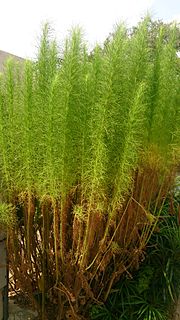
Artemisia scoparia is a Eurasian species in the genus Artemisia, in the sunflower family. It is widespread across much of Eurasia from France to Japan, including China, India, Russia, Germany, Poland, central + southwest Asia, etc.
Lasiococca is a plant genus of the family Euphorbiaceae first described in 1887. These are small to relatively large trees found in scrubs or semi-evergreen forests. They grow in India, Indochina, Southeast Asia, and southern China.
- Lasiococca brevipes(Merr.) Welzen & S.E.C.Sierra - Peninsular Malaysia, Philippines, Lesser Sunda Islands, Sulawesi
- Lasiococca chaniiThin - Vietnam
- Lasiococca comberiHaines - Hainan, Yunnan, Vietnam, Thailand, E India
- Lasiococca lociiThin - Vietnam
- Lasiococca symphylliifolia(Kurz) Hook.f. - Sikkim
Megistostigma is a genus of plant of the family Euphorbiaceae first described as a genus in 1887. It is native to southern China, Assam, and Southeast Asia.
- Megistostigma burmanicum - Assam, Myanmar, Thailand, Perlis
- Megistostigma cordatum - Sumatra, Sabah, Samar
- Megistostigma glabratum - Peninsular Malaysia, Anamba Islands, N Sumatra
- Megistostigma peltatum - Siberut, Natuna, Java
- Megistostigma yunnanense - Yunnan
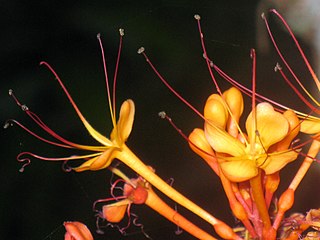
Saraca L. is a genus of flowering plants in the family Fabaceae of about 20 plant species of trees native to the lands from India, China and Ceylon to Malaysia and Sulawesi.
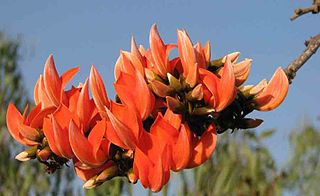
Butea is a genus of flowering plants belonging to the pea family, Fabaceae. It is sometimes considered to have only two species, B. monosperma and B. superba, or is expanded to include four or five species.
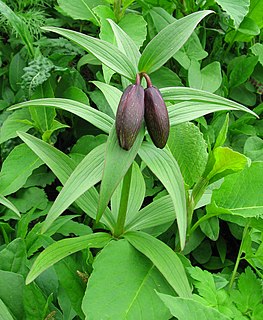
Fritillaria camschatcensis is a species of fritillary native to northeastern Asia and northwestern North America, including northern Oregon, Washington, British Columbia, Alaska, northern Japan, and the Russian Far East. It has many common names, including Kamchatka fritillary and Kamchatka lily.
Sindora tonkinensis is a species of legume in the family Fabaceae. This up to 15 m (49 ft) tall tree is native to Cambodia and Vietnam, and it is cultivated in Guangdong in southern China.

Abies spectabilis, the East Himalayan fir, is a conifer species in the family Pinaceae and the genus Abies. It is sometimes held to include the Bhutan fir as a variety. It is found in Afghanistan, China (Tibet), northern India, Nepal, and Pakistan. It is a large tree, up to 50 m (160 ft) tall.
Excoecaria benthamiana is a species of plant in the family Euphorbiaceae. It is endemic to Seychelles.
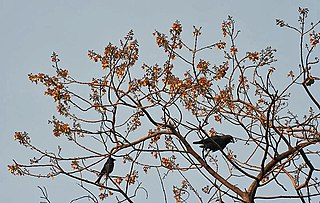
Gmelina is a genus of plants in the family Lamiaceae. It consists of about 35 species in Australia, New Guinea, New Caledonia, Southeast Asia, India and a few in Africa. Some species such as G. arborea have been planted and/or become naturalised in India, Africa and Australia. It was named by Carl Linnaeus in honour of botanist Johann Georg Gmelin.
Littledalea is a genus of Asian plants in the grass family, native to mountains in China and neighboring countries. The genus is placed in its own tribe Littledaleae within subfamily Pooideae. The isolated tribe seems to be sister to the tribes Bromeae and Triticeae.

Cremanthodium is a large genus of flowering plants in the daisy family.
Thiseltonia is a genus of Australian plants in the pussy's-toes tribe within the daisy family.

Saraca dives, is a tree species in genus Saraca belonging to the family Fabaceae, native to China, Laos, and Vietnam.
Sindora glabra is a tree of the family Fabaceae endemic to the People's Republic of China that grows in the provinces of Hainan, Fujian, Guangdong and Yunnan. The species is under second-class national protection in China.
Sindechites is a genus of flowering plants in the family Apocynaceae, first described as a genus in 1888. It is native to southern China, Laos, and Thailand.
Lygisma is a plant genus in the family Apocynaceae, first described as a genus in 1883. It is native to southern China, Indochina, Malaysia, and the Himalayas.
- Lygisma angustifolia(Wight) Hook.f. - Himalayas
- Lygisma flavum(Ridl.) Kerr - Peninsular Malaysia
- Lygisma inflexum(Costantin) Kerr - Vietnam, Guangdong, Guangxi, Hainan
- Lygisma nervosumKerr - Thailand

Quercus rex is an Asian species of tree in the family Fagaceae and the "ring-cupped oak" sub-genus. It has been found in the seasonal tropical forests of northern Indochina, northeastern India, and also in the Province of Yunnan in southwestern China.











